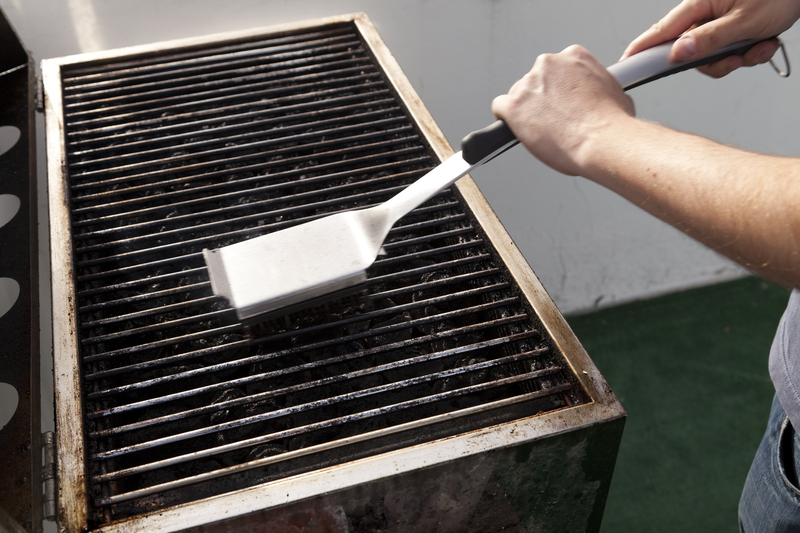A Professional's Guide to Car Cleaning and Detailing
Posted on 16/06/2025
A Professional's Guide to Car Cleaning and Detailing
Car cleaning and detailing is more than a weekend chore--it's an essential part of vehicle ownership that can boost your car's value, extend its lifespan, and promote a satisfying driving experience. In this comprehensive guide, you'll uncover the secrets and step-by-step methods the pros use for the ultimate car care. Whether you're a car enthusiast, a detailing newbie, or someone looking to elevate your regular cleaning routine, this article offers insights on auto detailing that will leave your vehicle sparkling both inside and out.
Table of Contents
- Why Car Detailing Matters
- Difference Between Car Cleaning and Detailing
- Essential Tools and Materials for Car Detailing
- Professional Exterior Car Cleaning Techniques
- Interior Car Detailing Guide
- Engine Bay Cleaning: The Professional Way
- Common Car Detailing Mistakes to Avoid
- Tips for Maintaining a Professionally Detailed Car
- Frequently Asked Questions on Car Detailing
- Conclusion
Why Car Detailing Matters
Unlike a quick wash, professional car detailing provides a thorough clean that addresses every aspect of your vehicle. Here's why detailing your car on a regular basis is important:
- Protects Paintwork: Removes contaminants that can erode or oxidize your vehicle's paint over time.
- Preserves Value: A clean, detailed car fetches a higher resale price and stays in better condition longer.
- Enhances Safety: Clean windows, mirrors, and lights ensure maximum visibility.
- Improves Comfort: A spotless interior creates a more pleasant driving experience and healthier environment.
- Prevents Damage: Deep cleaning helps keep mold, mildew, and salt corrosion at bay.
A professional detailing job will not only restore your car's showroom shine but protect your investment.
The Difference Between Car Cleaning and Detailing
It's common for car owners to confuse simple car cleaning with the art of auto detailing. Here's how the pros differentiate the two:
Car Cleaning
- Basic washing and vacuuming
- Removes surface dirt, debris, and some stains
- Refreshes appearance but does not address deeper grime or protection
Car Detailing
- Comprehensive cleaning: exterior, interior, wheels, engine bay, and glass
- Paint decontamination, polishing, and protection (waxing or ceramic coating)
- Restoration (sometimes correction) and preservation
- Intricate attention to detail-- Q-tips, brushes, compressed air, and other tools target hidden and stubborn grime
Think of detailing your car professionally as the difference between a quick shower and a spa day--it's a rejuvenation for your vehicle inside and out.
Essential Tools and Materials for Car Detailing
A professional car detailer relies on a vast array of products and gadgets. For the best car cleaning results at home, consider collecting these must-have tools:
- Two-bucket wash system (one for soapy water, one to rinse the mitt)
- Microfiber wash mitts & towels
- Detailing brushes in multiple sizes
- pH-neutral car shampoo
- Clay bar or synthetic clay mitt for decontaminating the paint
- Paint polish and/or scratch remover
- High-quality car wax or sealant
- Wheel cleaner and stiff brush
- Tire dressing
- Glass cleaner
- All-purpose cleaner (interior/exterior safe)
- Vacuum with attachments
- Leather cleaner and conditioner (for leather seating)
- Soft bristle upholstery brush
- Steam cleaner (optional for deep cleaning)
- Air compressor or can of compressed air
Investing in the right car detailing products ensures thorough results and helps prevent accidental scratches or damage.
Professional Exterior Car Cleaning Techniques
Step 1: Pre-Wash and Rinse
Start by rinsing off loose dirt with a hose or pressure washer. Use a snow foam cannon for extra lubrication to lift grime. Let the foam dwell a few minutes to break down contaminants.
Step 2: The Two-Bucket Wash Method
- Fill one bucket with clean water, another with soapy water.
- Use a microfiber mitt to gently wash from the top down--never circular scrubbing.
- After each section, rinse your mitt in the clean-water bucket to avoid dragging grit across the paint.
- Repeat as needed, paying extra attention to lower panels and bumpers.
Never use dish soap or household detergents--they strip essential wax and protection from your exterior!
Step 3: Paint Decontamination
- After washing, use a clay bar or synthetic mitt with detailing spray to remove bonded contaminants like tar, sap, or overspray.
- Work in small areas and keep the surface lubricated to avoid marring.
- You'll notice the paint becomes smooth as glass.
Step 4: Drying
- Use a plush, clean microfiber towel or car dryer to remove water before it dries and forms spots.
- Gently blot or pat, avoiding harsh rubbing.
- Detailers often use a quick detailer spray to enhance shine during drying.
Step 5: Paint Correction and Polishing
- If you spot swirl marks or fine scratches, use a quality polish, applied by hand or machine, to restore gloss and remove blemishes.
- Work in small areas, using light pressure, and always follow product instructions.
Step 6: Waxing or Sealing
- To protect the freshly cleaned surface, apply a layer of carnauba wax, synthetic sealant, or a ceramic coating.
- This adds both protection and a deep, hydrophobic shine.
Step 7: Wheels, Tires, and Trim
- Use a dedicated wheel cleaner and stiff brush to scrub brake dust from wheels and calipers.
- Clean and dress tires for a rich, matte finish.
- Plastic and rubber trims can be restored and protected with trim dressing.
Pro tip: Always tackle wheels and tires first--they're the dirtiest part of your car!
Interior Car Detailing Guide
Step 1: Declutter and Vacuum
- Remove all personal items and large debris.
- Vacuum seats, carpets, floor mats, cup holders, and between seats. Use attachments for tight spaces.
- Don't forget the trunk/cargo area.
Step 2: Cleaning Surfaces
- Use an interior-safe all-purpose cleaner and microfiber towel to wipe down the dashboard, door panels, and trim.
- Detailing brushes help reach buttons, vents, seams, and tight corners.
- Use compressed air to blow out dust from crevices.
Step 3: Upholstery and Carpet Care
- Spot clean stains with an upholstery cleaner or steam cleaner.
- If needed, use a dedicated carpet extractor for deep cleaning.
- For leather, use a pH-neutral leather cleaner and condition to prevent cracks and fading.
Let seats and carpet dry thoroughly to avoid musty odors.
Step 4: Glass and Electronics
- Clean all interior glass surfaces with a streak-free automotive glass cleaner.
- Wipe down digital screens with a soft microfiber cloth--avoid ammonia-based products.
- Use detailing swabs for the smallest nooks.
Step 5: Odor Elimination
- Neutralize odors with a fabric-safe deodorizer or ozone generator for persistent smells.
- Avoid strong scents that mask, instead of remove, bad odors.
A pristine interior is essential for professional auto cleaning results and overall well-being.
Engine Bay Cleaning: The Professional Way
Many car owners overlook the engine compartment, but a clean engine not only looks better but helps with spotting leaks and routine maintenance.
- Cover sensitive electronics and exposed air filters with plastic bags.
- Use an engine-safe degreaser. Let it dwell, then agitate with a soft brush.
- Gently rinse with low-pressure water--never blast directly into sensitive areas.
- Dry with microfiber towels and use compressed air for tight spaces.
- Finish off with a plastic or rubber protector for hoses and trim.
Warning: Never clean a hot engine; let it cool for at least 45 minutes before you begin.
Common Car Detailing Mistakes to Avoid
- Using dirty towels or sponges: These can scratch or swirl your paint.
- Washing in direct sunlight: Water spots and streaks form easily; always work in the shade.
- Neglecting hidden areas: Door sills, trunk jams, and under seats collect grime but are often ignored.
- Overusing product: Less is more when it comes to waxes, dressings, and cleaners.
- Skipping drying: Allowing your car to air-dry leads to water marks.
- Forgetting safety: Use gloves for chemicals and always read labels.
Tips for Maintaining a Professionally Detailed Car
- Wash regularly--at least every two weeks to prevent the buildup of damaging contaminants.
- Use quick detailer sprays between full details to refresh shine and remove light dust.
- Vacuum the interior weekly if possible, especially in high-traffic zones.
- Remove bird droppings and tree sap immediately--they can etch into paint within hours.
- Apply wax or sealant every three to six months for continued protection.
- Keep a mini detailing kit in your car for quick cleanups and emergencies.
- Address stains and spills right away to prevent permanent damage.
- Consider annual professional detailing even if you do maintenance at home.
Frequently Asked Questions on Car Detailing
How often should I have my car detailed?
Most professionals recommend full automotive detailing every 4-6 months, depending on your environment, driving habits, and storage.
Can I detail my car at home or should I visit a professional?
You can absolutely detail your car at home with the right supplies and patience. However, professionals have specialized tools--like rotary polishers and extractors--and experience. Consider pro detailing for tough stains, deep scratches, or when prepping for resale.
What's the difference between waxing and ceramic coating?
Both offer paint protection, but wax lasts about 1-3 months while a ceramic coating can protect your car for up to two years or more, providing superior water repellency and chemical resistance.
Will detailing remove all scratches?
Detailing removes light scratches and swirl marks; however, deep or through-the-clearcoat scratches may require touch-up paint or professional bodywork.
Is it bad to take my car through automatic washes?
While convenient, most automatic washes can inflict micro-scratches over time. Hand washing, as detailed above, is safest for your paint.
Conclusion
Achieving and sustaining a professionally detailed car isn't just about aesthetics--it's about care, value, and pride in ownership. By following this expert's guide to car cleaning and detailing, you'll keep your vehicle looking and feeling like new, impressing passengers and retaining long-term value. Invest in quality supplies, adopt proper techniques, and make detailing a regular part of your car care routine to enjoy every moment behind the wheel.
For more expert tips and detailed advice, make sure to revisit this professional detailing guide or consult your local auto detailing specialist for personalized recommendations.







